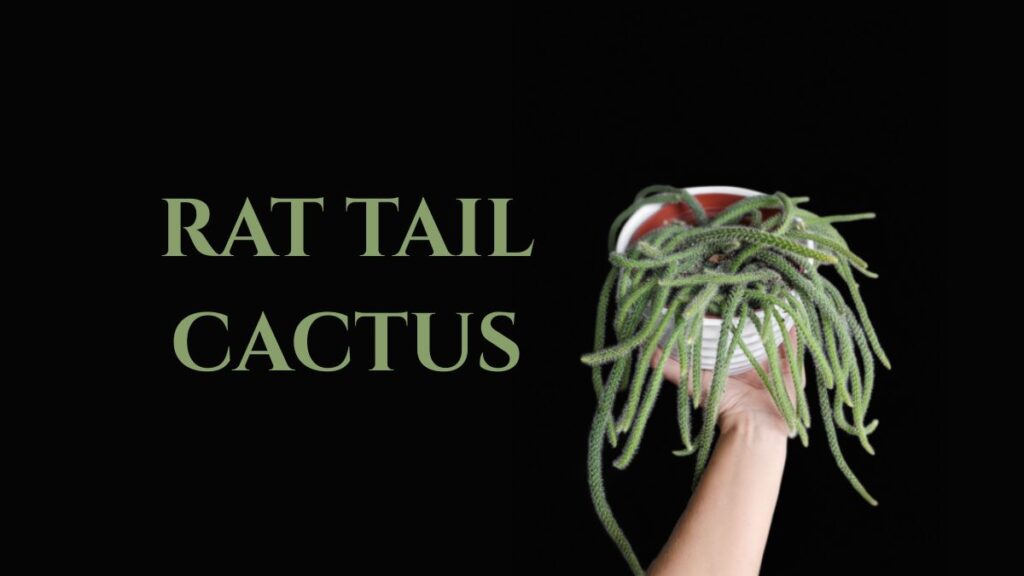Among the vast and diverse family of cacti, few are as visually striking and uniquely charming as the rat tail cactus. With its long, slender, trailing stems that resemble the tail of a rodent—hence its common name—this cactus brings a dramatic flair to any indoor or outdoor space. Native to the tropical forests of Mexico and Central America, the rat tail cactus defies the stereotypical image of desert-dwelling, spiny cacti. Instead, it thrives in humid, shaded environments, often growing as an epiphyte on trees in its natural habitat.
Unlike many cacti that require arid conditions and intense sun, the rat tail cactus prefers indirect light, regular moisture, and warm temperatures—making it an excellent candidate for hanging baskets or high shelves in homes and greenhouses. Its ability to produce vibrant, tubular flowers in spring and early summer adds another layer of appeal, transforming it from a curious oddity into a true showstopper.
In this comprehensive guide, we’ll explore everything you need to know about the rat tail cactus: its origins, ideal growing conditions, watering and feeding needs, blooming habits, propagation methods, common problems, and creative ways to display it in your home. Whether you’re a seasoned succulent enthusiast or a beginner looking for an eye-catching houseplant, this article will equip you with the knowledge to grow a healthy, flourishing rat tail cactus.
What Is a Rat Tail Cactus?
The rat tail cactus is the common name for plants in the genus Aporocactus, most notably Aporocactus flagelliformis. Sometimes, the name is also used more broadly to refer to similar-looking trailing cacti in related genera like Disocactus or Epiphyllum. However, true rat tail cactus species belong to Aporocactus, which includes about 10 recognized species.
These cacti are epiphytic or lithophytic, meaning they grow on trees or rocks rather than in soil. In the wild, they anchor themselves in moss, leaf litter, or crevices where organic matter accumulates, drawing moisture and nutrients from the humid air and decaying plant material. Their stems are cylindrical, segmented, and can grow up to 3–5 feet (1–1.5 meters) long, cascading elegantly downward. The stems are covered in fine spines arranged in neat rows along raised ridges, giving them a slightly bristly but not overly aggressive texture.
One of the most captivating features of the rat tail cactus is its flowering behavior. In late spring to early summer, mature plants produce clusters of brilliant magenta or pink, funnel-shaped flowers that can measure up to 2 inches (5 cm) across. These blooms appear along the upper portions of the stems and last only a few days—but their vivid color and abundance more than compensate for their short lifespan.
Natural Habitat and Origins
Understanding the natural environment of the rat tail cactus is key to replicating ideal growing conditions at home. Native to southern Mexico and parts of Central America—including Guatemala and Honduras—this cactus thrives in tropical and subtropical cloud forests. These forests are characterized by high humidity, frequent mist or rain, dappled sunlight filtering through dense canopies, and temperatures that rarely dip below 50°F (10°C).
In its native habitat, the rat tail cactus grows as an epiphyte, clinging to tree branches with its shallow root system. It doesn’t parasitize the host tree but instead uses it for physical support while absorbing moisture and nutrients from the air and decomposing organic matter around it. This epiphytic lifestyle explains why the rat tail cactus dislikes heavy, water-retentive soils and prefers airy, well-draining mixes that mimic the loose, organic debris found in tree canopies.
This ecological background is crucial for growers: attempting to treat the rat tail cactus like a desert cactus (with full sun and infrequent watering) will lead to stress, poor growth, and failure to bloom. Instead, it should be cared for more like a tropical plant—with consistent moisture, high humidity, and protection from harsh direct sunlight.
Ideal Growing Conditions
To keep your rat tail cactus healthy and encourage blooming, you must replicate its natural tropical forest environment as closely as possible. Here’s a breakdown of the optimal conditions:
Light Requirements
The rat tail cactus prefers bright, indirect light. An east- or west-facing window is ideal, where it receives morning or late afternoon sun without the intensity of midday rays. Direct, hot sunlight—especially through a south-facing window in summer—can scorch the stems, causing them to turn yellow or brown.
If grown outdoors (in USDA zones 10–12), place it under a shaded patio, beneath a tree canopy, or in a spot that receives filtered light. Never expose it to full sun for extended periods.
Temperature and Humidity
This cactus thrives in warm temperatures between 65°F and 85°F (18°C–29°C) during the growing season. It can tolerate brief dips to 50°F (10°C) but should never be exposed to frost or prolonged cold. In fact, a slight drop in temperature during winter (to around 55°F or 13°C) can help initiate flower bud formation—but avoid going lower than that.
Humidity is equally important. Aim for 50–70% relative humidity. If your home is dry—especially during winter with indoor heating—consider using a humidifier, placing the pot on a pebble tray filled with water, or grouping it with other plants to create a microclimate.
Soil and Potting Mix
Because it’s an epiphyte, the rat tail cactus needs a loose, fast-draining mix that doesn’t retain water. A standard cactus mix is often too dense. Instead, create your own blend using:
- 2 parts orchid bark or coarse perlite
- 1 part potting soil
- 1 part coconut coir or peat moss
- Optional: a handful of horticultural charcoal for added drainage and odor control
This mix provides excellent aeration and mimics the organic, airy conditions of tree branches. Ensure your pot has drainage holes—terracotta pots are ideal because they wick away excess moisture.
Watering Needs
Unlike desert cacti, the rat tail cactus appreciates consistent moisture during its active growing season (spring through fall). Water thoroughly when the top inch of the soil feels dry, allowing excess water to drain freely. Never let the plant sit in standing water, as this can cause root rot.
In winter, reduce watering significantly. Allow the soil to dry out more between waterings, but don’t let it become bone dry for weeks on end. The goal is to keep the stems plump and turgid, not shriveled.
Encouraging Blooms: The Secret to Flowering Success
One of the biggest frustrations for rat tail cactus owners is a plant that refuses to bloom. Fortunately, with the right care, this cactus can produce a spectacular floral display year after year.
Age and Maturity
First, ensure your plant is mature enough. Most rat tail cactus specimens won’t flower until they’re at least 2–3 years old and have developed long, trailing stems. Patience is key.
Light and Temperature Cues
Flower buds form in response to seasonal changes. In late fall and winter, give your plant a “rest period”:
- Move it to a cooler location (around 55°F or 13°C)
- Reduce watering
- Maintain bright, indirect light
This cool, dry rest mimics the slightly drier winter months in its native habitat and signals the plant to initiate bud formation. In early spring, gradually return it to warmer temperatures and resume regular watering. Buds should appear within weeks.
Avoid Over-Fertilizing
While feeding is important, too much nitrogen can promote leafy (stemmy) growth at the expense of flowers. Use a balanced, low-nitrogen fertilizer (such as 5-10-5) diluted to half strength every 4–6 weeks during the growing season. Stop fertilizing entirely in fall and winter.
Don’t Repot Too Often
The rat tail cactus tends to bloom better when slightly root-bound. Repot only every 2–3 years, and avoid disturbing the roots unnecessarily. Frequent repotting can reset the plant’s growth cycle and delay flowering.
If you want to read more, visit our blog page. We have more topics!
Propagation: Growing New Plants from Cuttings
One of the joys of owning a rat tail cactus is how easy it is to propagate. Whether you want to expand your collection or share with friends, stem cuttings are the way to go.
Step-by-Step Propagation Guide
- Take a Cutting: Use clean, sharp scissors or a knife to cut a healthy stem segment 4–6 inches (10–15 cm) long.
- Let It Callus: Place the cutting in a dry, shaded spot for 3–7 days to allow the cut end to form a protective callus. This prevents rot when planted.
- Plant the Cutting: Insert the callused end about 1 inch into your epiphytic cactus mix. You can dip it in rooting hormone (optional but helpful).
- Provide Warmth and Humidity: Keep the soil lightly moist and place the pot in bright, indirect light. A plastic bag or propagator can help maintain humidity.
- Wait for Roots: Roots typically form within 2–4 weeks. Once new growth appears, treat it like a mature plant.
Propagation is best done in spring or early summer when the plant is actively growing. Each cutting can produce a full, trailing plant within a year or two.
Common Problems and Solutions
Even with proper care, the rat tail cactus can encounter issues. Here are the most common problems and how to address them:
Stem Shriveling
This usually indicates underwatering or root rot (which prevents water uptake). Check the soil moisture and root health. If roots are mushy and black, trim them away and repot in fresh, dry mix.
Yellowing or Browning Stems
Often caused by too much direct sunlight or overwatering. Move the plant to a shadier spot and allow the soil to dry out more between waterings.
Lack of Blooms
As discussed earlier, this is typically due to insufficient light, no winter rest period, or excessive nitrogen. Adjust care accordingly.
Pests
While generally pest-resistant, the rat tail cactus can occasionally attract mealybugs, spider mites, or scale insects—especially in dry indoor environments. Treat infestations with insecticidal soap or neem oil, applied according to label instructions. Wipe stems gently with a cotton swab dipped in rubbing alcohol for mealybugs.
Fungal Issues
High humidity combined with poor air circulation can lead to fungal spots or rot. Ensure good airflow around the plant and avoid wetting the stems when watering.
Creative Display Ideas for Your Rat Tail Cactus
The trailing habit of the rat tail cactus makes it perfect for creative displays:
- Hanging Baskets: Suspend it near a bright window where its stems can cascade freely. Use a wire or macramé hanger for a boho-chic look.
- Shelving: Place it on a high shelf or bookcase so the stems drape over the edge, adding vertical interest to your room.
- Terrariums (Open): While closed terrariums are too humid, an open glass container can showcase its form—just ensure excellent drainage.
- Mixed Planters: Combine it with other epiphytic plants like orchids, bromeliads, or string of pearls for a lush, tropical arrangement.
- Outdoor Summer Display: In warm months, hang it on a shaded porch or balcony to enjoy fresh air and natural humidity.
Avoid placing it in high-traffic areas where the spiny stems might snag clothing or skin—though the spines are relatively soft, they can still be irritating.
Seasonal Care Calendar
To simplify care, here’s a month-by-month guide:
- Spring (March–May): Increase watering as new growth appears. Begin fertilizing. Watch for flower buds. Provide bright, indirect light.
- Summer (June–August): Water regularly. Protect from hot afternoon sun. Maintain humidity. Continue light feeding.
- Fall (September–November): Gradually reduce watering. Stop fertilizing. Begin moving to a cooler location if possible.
- Winter (December–February): Keep in a cool (55°F), bright spot. Water sparingly—only when stems begin to soften slightly. No fertilizer.
This seasonal rhythm supports healthy growth and reliable blooming.
Conclusion
The rat tail cactus is far more than just a quirky houseplant with an unusual name. It’s a stunning example of nature’s adaptability—thriving not in deserts, but in the misty treetops of tropical forests. With its dramatic trailing stems and bursts of vivid pink flowers, it brings a touch of exotic beauty to any indoor space.
Caring for a rat tail cactus requires understanding its unique needs: bright but indirect light, consistent moisture during growth periods, high humidity, and a cool winter rest to encourage blooming. When these conditions are met, the plant rewards you with vigorous growth and a breathtaking floral show.
Whether you’re propagating new plants from cuttings, troubleshooting common issues, or finding the perfect spot to display its cascading form, the rat tail cactus offers endless opportunities for enjoyment and learning. It’s a plant that challenges assumptions about what cacti can be—and proves that even the most unexpected succulents can flourish with the right care.
So if you’re looking to add a conversation-starting, low-maintenance (once established), and visually spectacular plant to your collection, look no further than the rat tail cactus. With patience and attention to its tropical roots, you’ll be rewarded with a living cascade of green—and a springtime explosion of color—that will delight for years to come.







